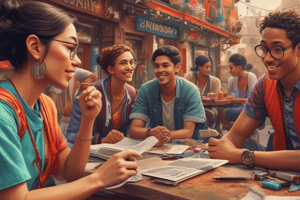Podcast
Questions and Answers
Which of the following scenarios best illustrates the concept of 'social mobility'?
Which of the following scenarios best illustrates the concept of 'social mobility'?
- A community establishes new norms and values that differ from the wider society.
- An individual chooses to identify with a different ethnic group than the one they were born into.
- A child from a low-income family becomes a successful doctor through education and hard work. (correct)
- A person maintains the same job and social standing as their parents.
A large corporation relocating its production facilities to a country with lower labor costs is an example of what sociological phenomenon?
A large corporation relocating its production facilities to a country with lower labor costs is an example of what sociological phenomenon?
- Globalization (correct)
- Cultural diffusion
- Social mobility
- Social stratification
Which of the following best describes the role of 'social institutions' in society?
Which of the following best describes the role of 'social institutions' in society?
- They are individual efforts to challenge social norms.
- They are temporary groups formed to address specific social problems.
- They are established patterns of behavior and social structures that perform essential functions. (correct)
- They are informal gatherings of people with shared interests.
How does 'symbolic interactionism' contribute to our understanding of social interaction?
How does 'symbolic interactionism' contribute to our understanding of social interaction?
What is the primary difference between 'race' and 'ethnicity' as sociological concepts?
What is the primary difference between 'race' and 'ethnicity' as sociological concepts?
Which of the following is an example of 'informal social control'?
Which of the following is an example of 'informal social control'?
How does the concept of 'social stratification' affect access to resources and opportunities?
How does the concept of 'social stratification' affect access to resources and opportunities?
What role do 'agents of socialization' play in the development of an individual?
What role do 'agents of socialization' play in the development of an individual?
Which of the following factors is most likely to drive 'social change'?
Which of the following factors is most likely to drive 'social change'?
How do 'social movements' typically emerge?
How do 'social movements' typically emerge?
Flashcards
Sociology
Sociology
The systematic study of human society and social interactions, examining structures, processes, and dynamics shaping human behavior, social groups, and institutions.
Society
Society
A group of people in a defined space sharing a common culture, including norms, values, beliefs, and institutions.
Culture
Culture
Shared values, beliefs, norms, symbols, language, and material objects characterizing a group or society; learned and transmitted across generations.
Socialization
Socialization
Signup and view all the flashcards
Social Structure
Social Structure
Signup and view all the flashcards
Social Interaction
Social Interaction
Signup and view all the flashcards
Social Groups
Social Groups
Signup and view all the flashcards
Social Institutions
Social Institutions
Signup and view all the flashcards
Social Stratification
Social Stratification
Signup and view all the flashcards
Social Class
Social Class
Signup and view all the flashcards
Study Notes
Sociology
- Sociology involves the systematic study of human society and social interactions.
- It examines the structures, processes, and dynamics that shape human behavior, social groups, and institutions.
- Sociological concepts offer frameworks for analyzing social phenomena.
Society
- A society constitutes a group sharing a common culture, residing in a defined territory.
- Shared norms, values, beliefs, and institutions are key elements.
- Societies can vary in size, from small communities to large nation-states.
Culture
- Culture encompasses shared values, beliefs, norms, symbols, language, and material objects characterizing a group or society.
- It is both learned and transmitted across generations.
- Culture shapes perceptions, behaviors, and interactions among people.
Socialization
- Socialization involves individuals learning societal norms, values, and behaviors.
- It takes place throughout life, particularly during childhood and adolescence.
- Family, school, peers, and media are key agents.
Social Structure
- Social structure refers to patterned relationships and social institutions within a society.
- It involves elements like social hierarchies, roles, and norms.
- Social structure impacts both individual behavior and social interactions.
Social Interaction
- Social interaction is how individuals act and react to one another.
- Communication, cooperation, competition, and conflict are involved.
- Symbolic interactionism highlights the role of symbols and meanings.
Social Groups
- Social groups consist of people sharing a common identity and interaction.
- Primary groups entail intimate relationships, like family and friends.
- Secondary groups are more impersonal, such as workplaces and organizations.
Social Institutions
- Social institutions are established behavior patterns and social structures meeting essential societal functions.
- Examples include family, education, religion, government, and the economy.
- Institutions offer a framework for social life and social order.
Social Stratification
- Social stratification involves the hierarchical arrangement of individuals and groups in society.
- It's based on wealth, income, occupation, education, and status.
- This results in unequal access to resources and opportunities.
Social Class
- Social class defines a system of stratification based on economic factors.
- Upper, middle, and lower classes are typically included.
- Class position shapes life chances and social mobility.
Social Mobility
- Social mobility involves movement between different social positions.
- Upward mobility means moving to a higher social class.
- Downward mobility means moving to a lower social class.
Deviance
- Deviance involves behavior violating social norms and expectations.
- What's considered deviant differs across societies and cultures.
- Theories include strain, labeling, and control.
Social Control
- Social control involves mechanisms regulating individual behavior in society.
- Formal social control includes laws, police, and the criminal justice system.
- Informal social control includes norms, customs, and social pressure.
Power
- Power is the capacity to influence or control others' behavior.
- Authority is legitimate power, recognized and accepted by society.
- Types of authority include traditional, charismatic, and rational-legal.
Social Change
- Social change involves transforming social structures, institutions, and cultures over time.
- It's driven by technological innovation, social movements, and demographic shifts.
- Social change may be gradual or revolutionary.
Globalization
- Globalization involves increasing interconnectedness and interdependence of societies.
- It entails flows of goods, capital, information, and people across borders.
- Globalization carries significant social, economic, and cultural implications.
Social Movements
- Social movements entail organized groups promoting or resisting social change.
- They arise in response to perceived injustices or inequalities.
- Social movements can be local, national, or global.
Gender
- Gender refers to the socially constructed roles, behaviors, expressions, and identities of individuals.
- It is distinct from biological sex.
- Gender affects experiences, opportunities, and social interactions.
Race and Ethnicity
- Race is a social construct based on perceived physical differences.
- Ethnicity involves shared cultural heritage, language, and traditions.
- Racism and ethnic discrimination can cause social inequality and conflict.
Urbanization
- Urbanization is the increasing concentration of a population in urban areas.
- Cities serve as hubs of economic activity, culture, and innovation.
- Urbanization might lead to social issues like poverty, crime, and environmental decline.
Demography
- Demography studies population size, composition, and distribution.
- Key factors include birth rates, death rates, migration, and age structure.
- Demographic trends exert significant social and economic impacts.
Studying That Suits You
Use AI to generate personalized quizzes and flashcards to suit your learning preferences.




